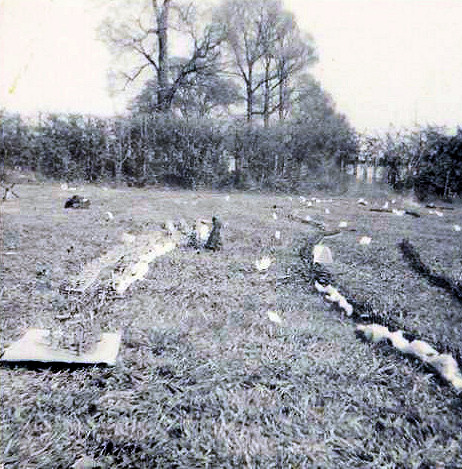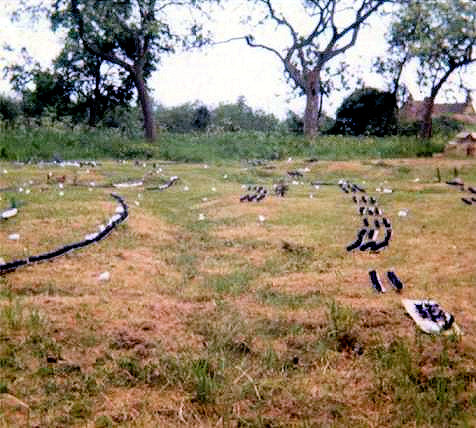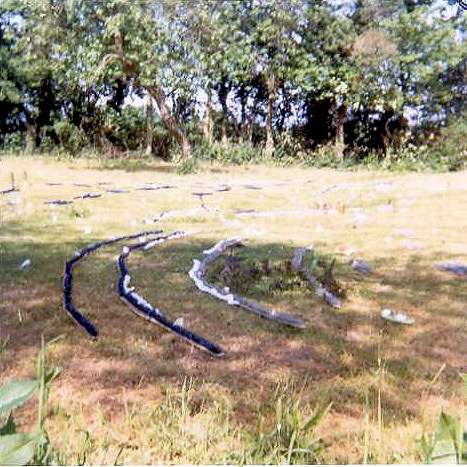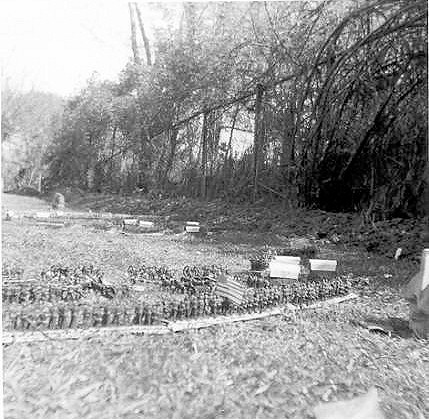Just for you good folk who have contacted me concerning military history and war gaming – well, as you can see herewith – I have indeed played many war games, but not necessarily ones along conventional lines.
Arguably the largest outdoor war game ever played, my 1971 American Civil War battle was a fictional affair, but roughly based on events occurring during the Seven Days Battle of 1862.
Using almost 14,000 Airfix H0/00 figures, and a battlefield measuring 10 meters by 15 meters, the whole battle took two days to complete, this being allowed for by the fact that, being plastic, the figures could remain outdoors during the night, and a untypical British summer dry-spell, when it did not rain for four consecutive days!
The rules were taken from Donald Featherstone’s book ‘War Games,’ together with additions giving greater scope for troop deployment and movement. I also included rules which allowed for a change in orders to various divisions and brigades, but which had to be delivered by couriers, who were susceptible to being captured. wounded or killed, thus creating a “Fog of War.” Troops not receiving orders were to proceed as per the initial instructions given to their commanders at the commencement of the game. By the same token, if a commander could throw a five of six on the dice, then he was allowed to act upon is own discretion, or as circumstances dictated.
The Union army consisted of three corps; each with three divisions containing three brigades of three regiments each. A regiment was roughly 100 strong, giving a total of around 8,000 men. Each corps had 12 cannon in four batteries of 3 guns each. When the wagon train and staff were added the grand total came close to 8,400.
The Confederate army contained two corps; each of three divisions of three brigades each. Each brigade had three regiments of approximately 100 men each, and each corps had four batteries of artillery with 3 guns each. This gave the Confederates a total of just over 5,500 troops, when staff and wagon trains were added.
On the Union side there were four players, one for each corps and an overall field commander who wrote out the original battle orders for each of his corps commanders to follow, plus issuing additional instructions as the game progressed. The Confederate “team” sported two corps commanders plus a commander-in-chief who, like his counterpart on the Union side, issued battlefield orders.
Not being able to find the original notes that were taken as the battle progressed, I will endeavour to explain what occurred briefly period by period.
The battle was a simple affair. The object of the Union army was to drive the Confederates from their position and capture the town of Mechanicsville. The object of the Confederates was to stop the Union achieving their goal. The discrepancy in troop numbers for the Confederates was made up for somewhat by their being on the defensive, plus also having field works along most of their forward position.
The action was divided into eight game periods. This was decided upon owing to the time factor involved in moving thousands of troops, and having to resolve each artillery and infantry move plus fire effect and morale, together with alternate instructions being issued by each commanding general, all of which took over one hour to complete. Thus the first day of the battle lasted from 11 o’clock in the morning until 4 o’clock in the afternoon, by which time, even allowing for refreshments being constantly available, most of us thought it time to wash-up and pop back to the pub (the battle was fought in the orchard of my [then] public house, ‘The Oak” at Defford/Woodmancote, Worcestershire.)
Period 1.
The Union commander launches a massive attack on the Confederate left wing, throwing in a whole corps in an attempt to get things over quickly. Unfortunately his build-up to the attack had been spotted in time and the Confederate commander moved troops rapidly from his central reserve, hitting the Union battle line in flank as they moved to engage the rebel left wing. Lucky dice throws saved the Union from total destruction on this part of the field, however they were badly cut -up and fell back to their original positions with their morale severely shaken, which meant that they could not be used on the offensive for the next game period.

While the Union attack was going in on the Confederate left, a divisionary attack was in progress on their right. Here the Union commander dithered about, making it quite obvious that the main assault was coming elsewhere. With only one Union brigade involved, together with much re-grouping of their support troops by the blue commander, the Confederates were able to send in a spoiling counter attack which soon caused the Federal units to fall back, but not before they had managed loose a complete battery of artillery.

Period 2.
After regrouping his much battered and demoralised First corps, the Union commander decided to try his luck against the Confederate centre, which had been depleted by the previous blue attack on their left. This plan looked promising, as with a full corps as yet uncommitted and the grey lines thinned in the centre, a major break through did indeed seem possible. Once again this attack was ruined by faulty troop deployment. Not having learnt anything from the defeat of his First corps, which had advanced with exposed flanks, the Union command repeated this error and the Confederates were quick to take advantage of the situation. Hitting both flanks of the Union attacking formation simultaneously, the whole mass was forced back with very heavy losses, including two whole regiments who surrendered, and three more so badly cut up that they took no further part in the game.

Period 3.
This was spent with both sides rearranging their troops and testing the morale of the various units who had been involved in the central action. The Union First corps over on their right had now been reformed and was again ready for action, while their Third corps on the left was forced to send one of its divisions to bolster the much depleted Second corps in the centre. The grey lines were content to re-group, still holding their original positions, and await the next Union blunder.
Period 4.
Having a severe attack of jitters, the Union command did nothing during this period except push a strong line of skirmishes forward to protect their front, fully expecting the Confederates to launch an attack against their weakened centre. This never materialised, as the “Johnny Rebs” were happy to let the blue masses batter themselves against their line as they had been doing thus far at great cost.
End of Day One.
Day Two.
After going into a huddle over a few pints of beer the previous evening, the Union team decided to try a more supple approach.

Period 5.
Pushing forward a strong artillery line, consisting of six batteries, two brought over from the Union centre, the blue divisions of their First corps now began to attempt an outflanking manoeuvre around the Confederate left. This time their flanks were well protected, and their artillery line supported by several regiments. Things began to go well, as the Union brigades swung into line of battle and forced the much weaker grey brigades gradually back towards the centre. Unfortunately, with many of their regiments in the centre immobilised due to the thrashing they had received the previous day, the Union command attempted to bring troops over from their left to engage the Confederate troops in the centre, in order to stop them reinforcing their left. This did not work out well for the blue army. Although they moved troops to cover any attack coming in from the Confederate right flank, they created a gap between their forces allowing the Rebs to push forward three of their brigades, which wheeled to their left and caught the advancing blue units moving towards the centre. Once again things began to unravel rapidly on the Union side. The outflanking attack on the Confederate left stalled, as troops were sent to assist their beleaguered blue comrades in the centre, while away on the right of the grey line the Union troops sent in to keep the enemy occupied suffered a resounding defeat by advancing too far without adequate artillery support. The result of all this was a complete route of the Union forces across the whole field. Only a few of the regiments involved managing to make their way back to their own lines in one piece.

Period 6.
It was now decided that, because of the losses incurred, and the state of morale in many of the Union regiment, a decision should be made as to whether it was possible for them to continue the battle. They still had a few thousand men available who had not been directly affected by the disaster, but it was thought that these would also, under “actual” circumstances, be demoralised by what had happened to their comrades. Therefore the Union team agreed to a “roll of the dice.” Only by throwing two sixes could they continue the battle. A roll of a five and a six meant that they could take one full period to reform and then continue, but since the time factor was against this it was considered that they could hold their position but not attack. Two fives thrown allowed them to retire in good order. Anything below five would cause them to quit the field in disorder – and so it was.

The losses, which had been carefully recorded by an independent referee, came to 1,340 Union killed and wounded, plus 1,000 prisoners and 14 cannon. [1]It was decided that each regiment engaged would suffer wounded as well as killed. The former being a percentage taken from the overall “hits” that a regiment received during combat. These were … Continue reading The Confederates lost far less, suffering only 865 killed and wounded and 300 captured, the latter being liberated as the Union army fell back.
The war gamer can never really achieve anything like a true battlefield situation, even with the most elaborate rules. What the outdoor war game did show was just how much fun could be had by using large troop numbers, which at least made the game “look” more realistic!
I must apologise for the quality of the photographs taken during the battle. Only having a Kodak Instamatic camera, plus a limited amount of colour film, and also allowing for the time these pictures have been kicking around (almost forty years!), I feel lucky that any record of the game has existed this long.
Graham Morris.
July 2009
References
| ↑1 | It was decided that each regiment engaged would suffer wounded as well as killed. The former being a percentage taken from the overall “hits” that a regiment received during combat. These were considered to be still fit to carry on until the next period of the game when, after another fire fight, or coming under artillery fire, they were then added to the list of killed. The wounded from this period going into the next round in a similar manner. |
|---|

Thanks Bruce!
Graham (battlefield anomalies)
Awesome!